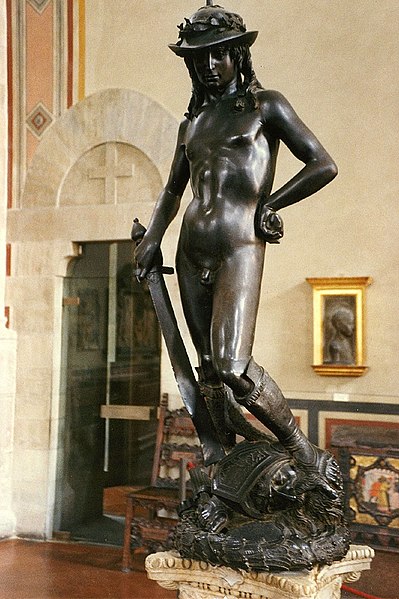The first one was a David by Donatello, aka Donato di Niccolò di Betto Bardi (c. 1386 - December 13, 1466), an early Renaissance Florentine sculptor. This elegant dandy, the first free-standing bronze sculpture that was completely unsupported and in nude form in the Renaissance period, depicts David of the legend standing with his left foot atop the head of the slain Goliath. In contrast Michelangelo's David before the action, here, the almost feminine hero, left hand on hip, and right holding the large sword, was depicted at the moment after the great deed. Yet, he was equally sedated and almost remorseful, much like the sadness after a sexual ecstasy.
The sculpture was highly polished and beautifully detailed, and its verisimilitude was so startling, it must be difficult to gaze upon, particularly because that this David was of human scales, unlike that god-like David by Michelangelo. For example, looking at the profile of this David, one would be struck by the slightly protruding belly and sagging buttock. His beauty was so overwhelming that it was impossible not to be moved and almost inappropriate to praise openly.


David by Donatello
Patrick A. Rodgers

Gianbologna (Giambologna)
Mercurio (Mercury)
1580
The other beautiful nude sculpture was Mercury by Gianbologna, or Giambologna, born as Jean Boulogne, incorrectly known as Giovanni da Bologna and Giovanni Bologna (1529 - 13 August 1608), who was a late Renaissance sculptor, noted for his marble and bronze statues. His style was in late Renaissance or Mannerist style.
Mercury, though beautifully formed, was somewhat more abstract than Donatello's David. It was less a narrative piece; rather, it presented to the viewers an exuberant youth, with his upwards or airborne motion, it became a celebration of a wonderful form and a certain spirit it entailed, rather than a depiction of a figure or an event. Mercury's body, from winged left ankle, up to his back-bent torso, and rotating right arm, and the index finger, which separated from other fingers, pointing straightly towards the sky, created a dynamic rhythm and was the textbook illustration of Figura Serpintina, an Italian term used to characterize the twisted, convoluted figures of of Mannerist sculptures.
My Favorite Museum Collection Series
>> My Favorite Museum Collection Series 19: My Favorite Sculptures at Museo dell'Opera del Duomo (Florence)
<< My Favorite Museum Collection Series 17: My Favorite Paintings at Palatina Gallery, Palazzo Pitti, Firenze, Italia





No comments:
Post a Comment